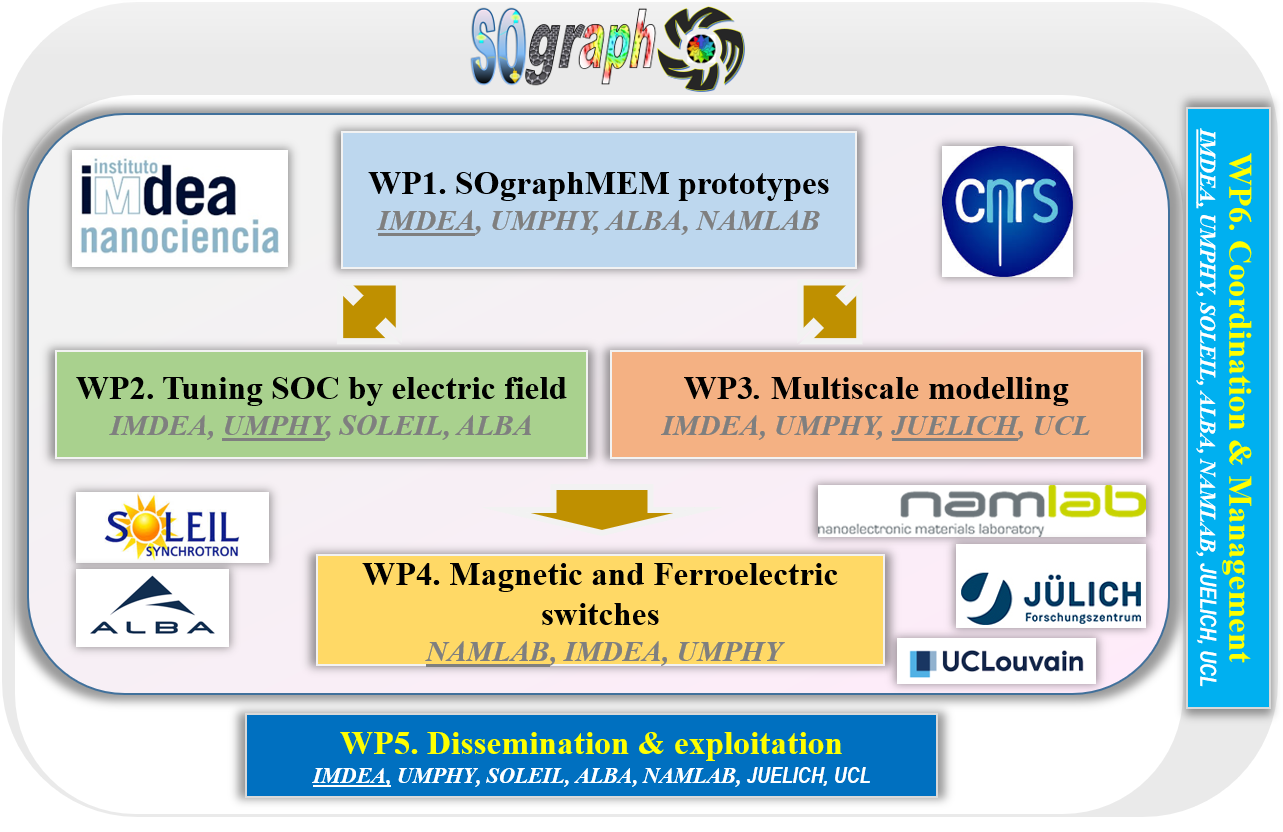ABOUT
SOgraphMEM – Spin Orbit functionalized GRAPHene for resistive-magnetic MEMories
Funding organism: National research agencies, MINECO Spain, ANR France, DPG Germany, FNRS Belgium, upon recommendation/evaluation from European Union
Participating organisms: IMDEA Nanociencia (Spain), CNRS-UMPHY (France), Soleil (France), ALBA-CELLS (Spain), NaMLab gGmbH (Germany), Peter Grünberg Institute (PGI) & Institute for Advanced Simulation (IAS) – Forschungszentrum Jülich (Germany), Université Catholique de Louvain (Belgium).
Coordination: Dr. Paolo Perna
Total budget: 1.1 M€ from: 1st January 2020 to 31st December 2022





Summary of the proyect
The demand for high density, low power and fast spin logic devices requires the combination of materials that can provide suitable spin transport channels with long spin lifetime and spin propagation, as well as topologically stable spin textures that can act as fast information carriers. These prerequisites for the development of spintronic technology in next years can be fulfilled by exploiting the spin and momentum degrees of freedom of electrons (Spin-Orbitronics, SO) in specific multi-layered structures. In addition, the discovery of a strong Dzyaloshinskii−Moriya Interaction (DMI) at the Graphene (Gr)/Ferromagnetic (FM) interface is a crucial step to promote SO technology enabling the electrical control of the transport and manipulation of (topologically protected) magnetic structures.
The integration of graphene as efficient spin transport channel in the technology based on chiral spin textures depends, however, on our ability to fabricate Gr-based perpendicular magnetic anisotropy (PMA) systems with tailored interfacial Spin Orbit Coupling (SOC). The partners of the consortium have already demonstrated the ability to tune the SOC by metal intercalation and the important magnetic interactions including the perpendicular anisotropy, the interlayer dipolar fields or the interfacial DMI by layer engineering, in order to control the chirality of the magnetic domain walls and skyrmions, to detect electrically nanometer spin textures, to realize graphene mediated antiferromagnetic coupling (AFC) between FMs, and finally to engineer ferroelectricity for application in various flavours of ferroelectric memories.
Main objectives
SOgraphMEM project aims to i) functionalize the SOC induced parameters, ii) characterize, and iii) test the graphene based Spin-Orbitronic systems/devices operating at room temperature by exploiting the advantages of combining FM ultrathin films underneath of a Gr layer, non-magnetic films of heavy metals (HM), and ferroelectric (FE) compounds (doped-HfO2, HfZrO2). We aim at exploiting the polarization of the FE in order to ultimately realize voltage-controlled resistive and magnetic switching devices. We will adopt a specific methodology to fabricate the stacks, which will have the following sequence FE / Gr / FM / HM onto insulating oxides. In order to stabilize the spin textures, we will also explore the use of AFC through Gr in synthetic antiferromagnetic (SAF) stack, i.e. FM2 / Gr / FM1.
In view of practical applications, SOgraphMEM will open the way for the development of the next generation of spintronics devices beyond the Moore’s law, exhibiting low power, high velocity and large density, as well as efficient spin injection/detection.
- Objetive 1. Realization of SOgraphMEM prototypes.
- Objective 2. Effects of electric field on the magnetic anisotropy and DMI.
- Objective 3. Characterization of the magneto-transport, magnetization dynamics and spin-orbit and spin-transfer torque effects as a function of applied electric and magnetic fields.
- Objective 4. Magnetic and ferroelectric switches.

An interdisciplinary consortium
The SOgraphMEM consortium is composed by seven research institutions (IMDEA, UMPHY, SOLEIL, ALBA, NAMLAB, JUELICH and UCL) from four EU countries (Spain, France, Germany, Belgium) and comprises a group of experts in the required fabrication and characterization techniques, in multiscale theory, as well as the facilities and engineering expertise to produce the proposed systems/devices. In addition, the Consortium complements the capabilities already available at the Graphene Flagship, making available a list of sophisticated techniques.
Work Plan








